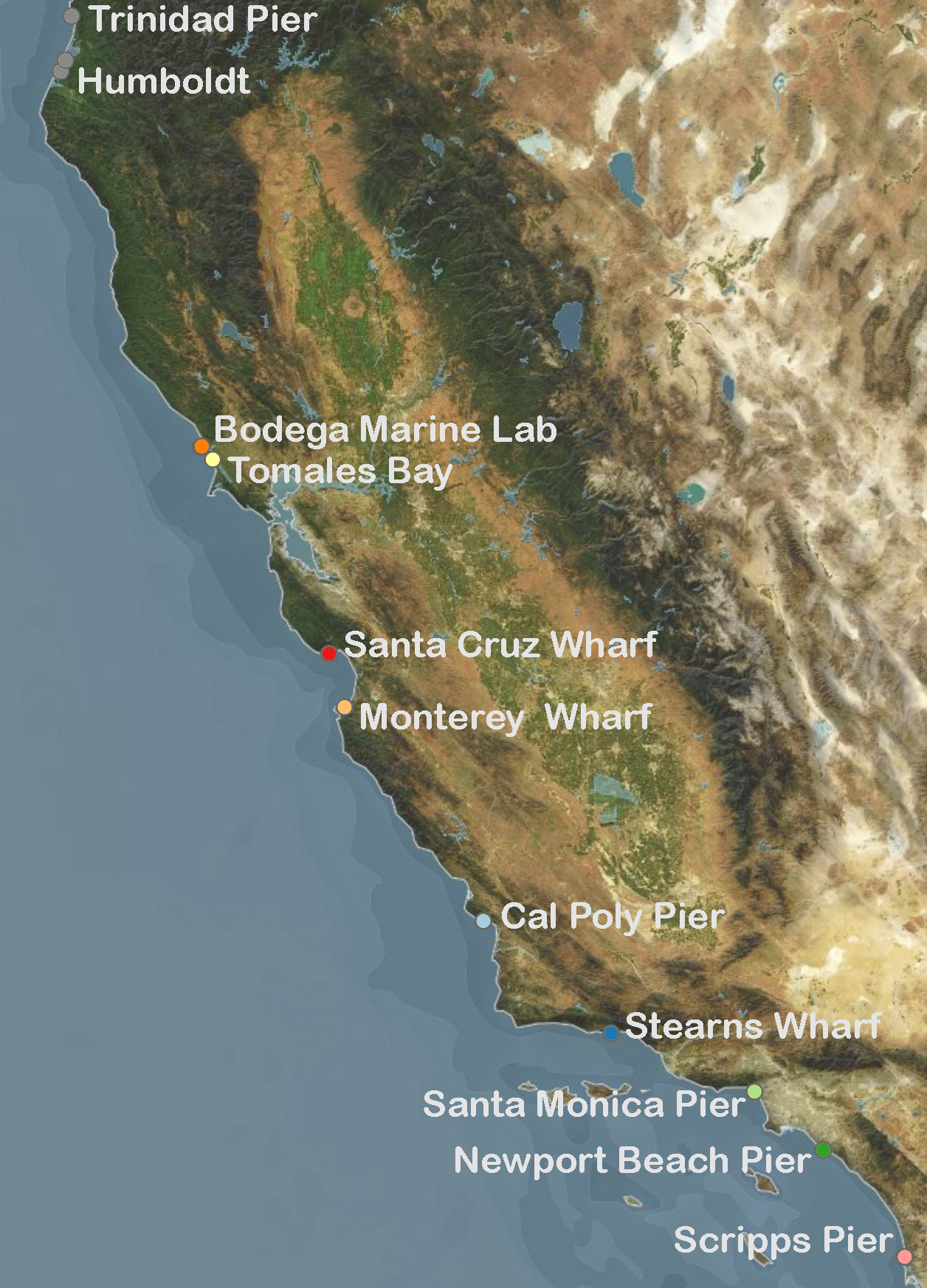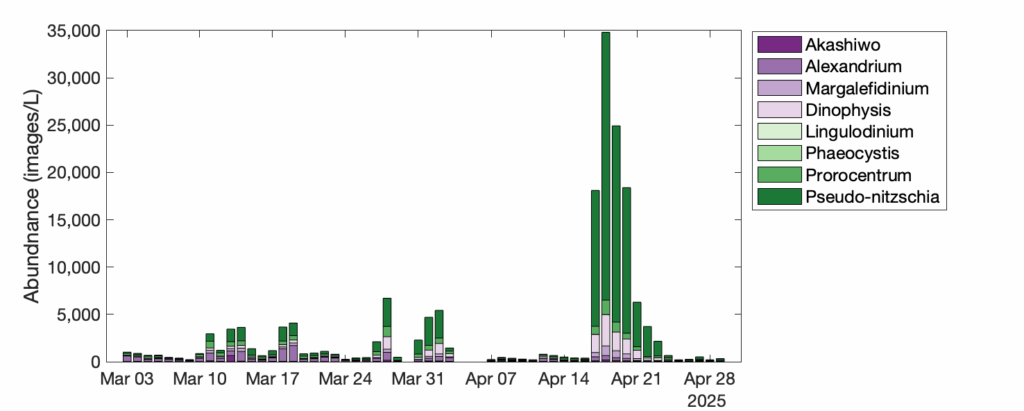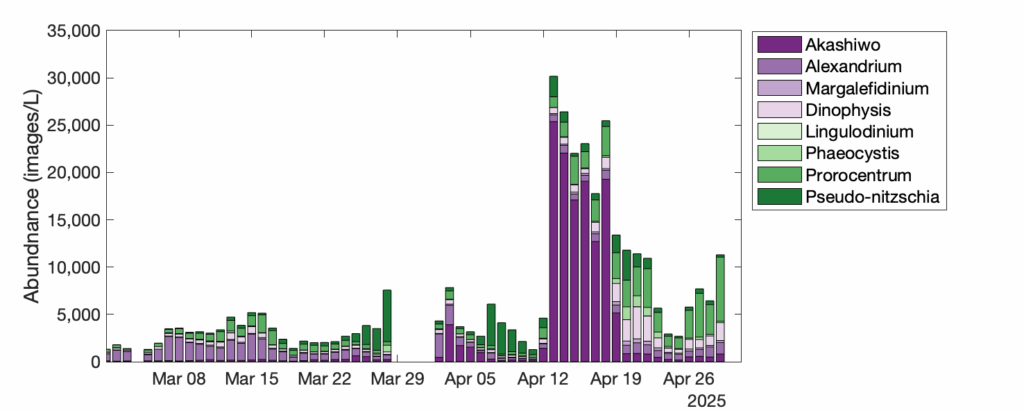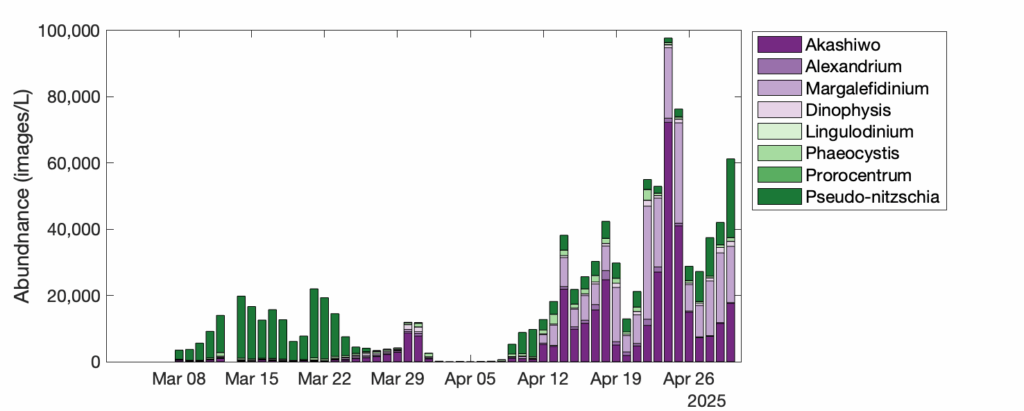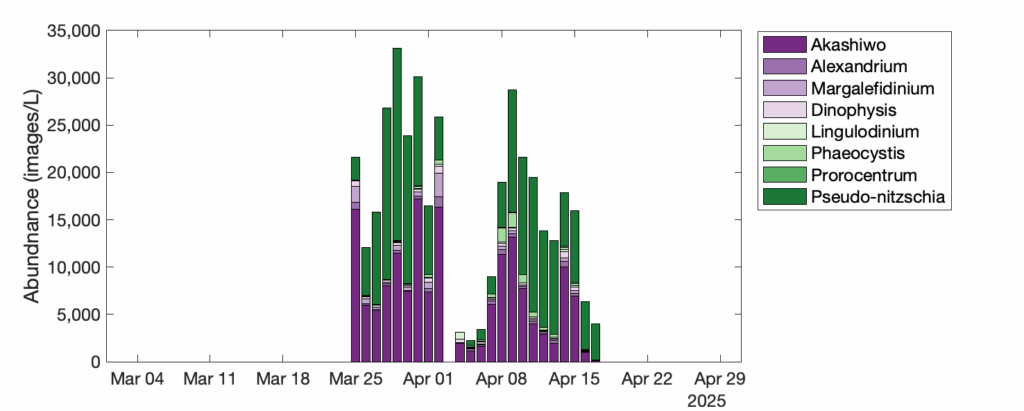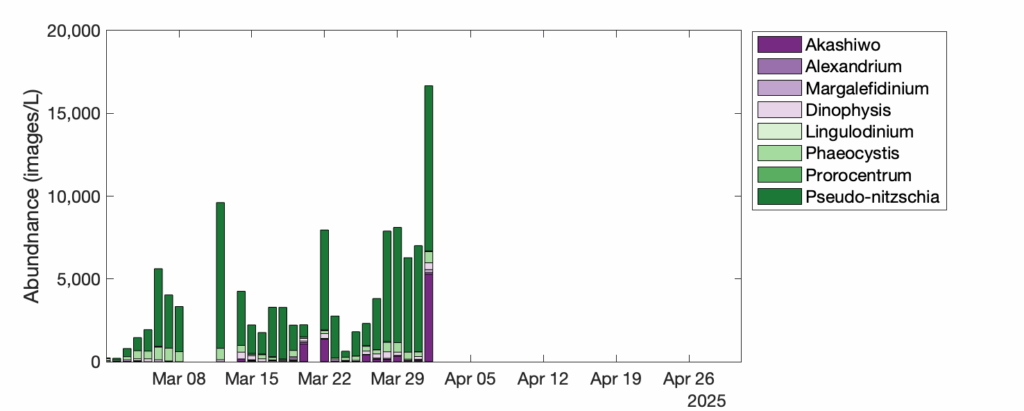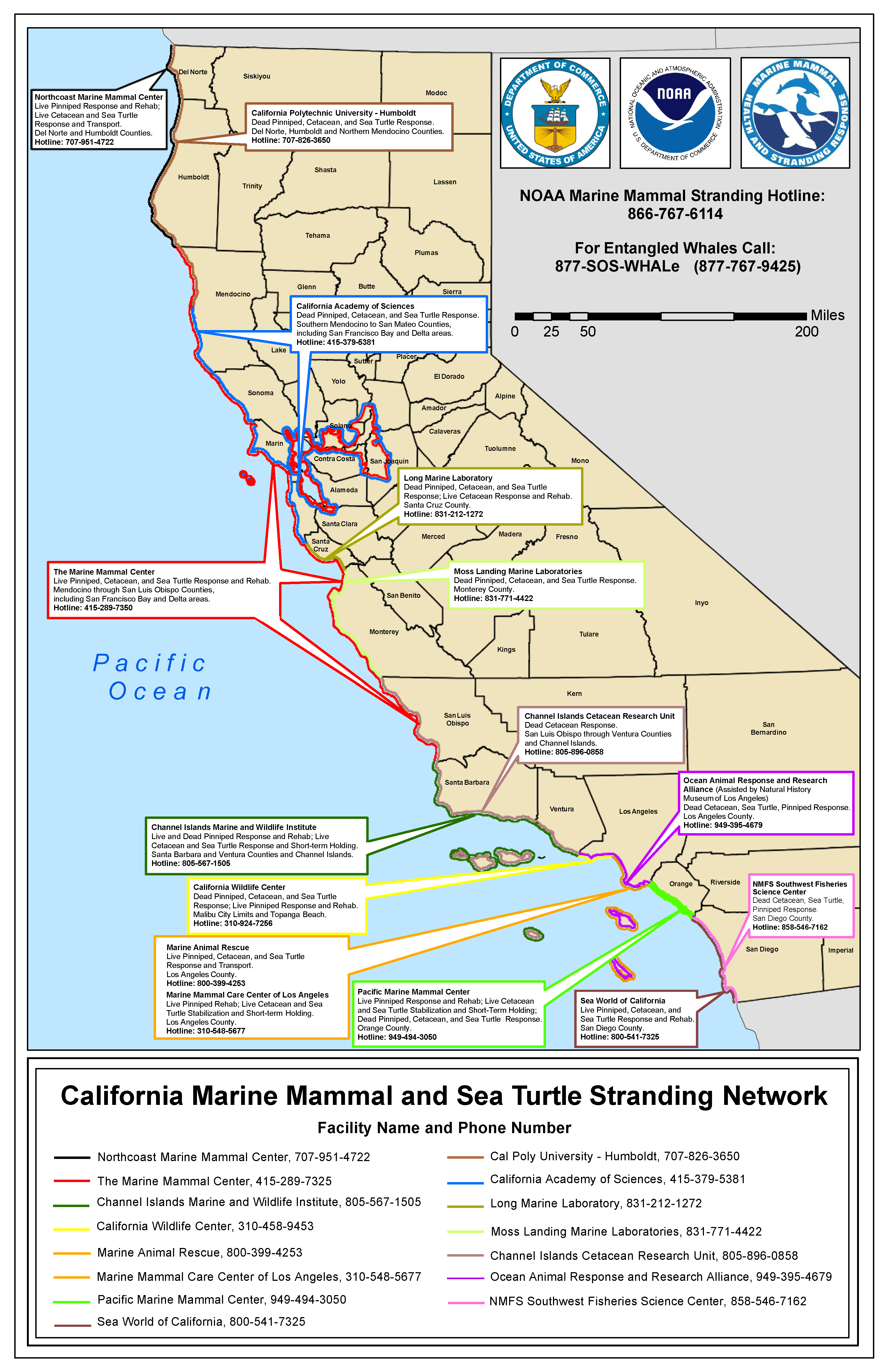March - April 2025
Summary written by Dr. Kasia Kenitz & Dr. Clarissa Anderson on May 5th
-
- SUMMARY: This bulletin summarizes a major domoic acid (DA) event also captured in the Dec-February bulletin. Over the past few months, the central and southern California coast has been battling an intense series of harmful algal bloom (HAB) events, with March and April standing out as the most critical and severely impacted months so far this year. The ecological impacts observed during this period have surpassed those of the past four years, with toxins affecting CA sea lions and other pinnipeds, dolphins, sea birds, larger cetaceans, and producing shellfish advisories from Santa Barbara to San Diego. Very high levels of DA detected in sardine tissue prompted state agencies to recommend recreational fishery restrictions in Southern California. The biological toll of this multi-faceted toxic event has been staggering. Animal strandings far exceeded those reported in any of the toxic events over the past four years, with more than 1,670 stranded animals reported to date, over 1250 of which were in Los Angeles, Ventura, and Santa Barbara counties. The longest, nearshore cold water episode since the La Niña year of 2011 likely contributed to the origin of this bloom period as early as December 2024 in Baja and at Scripps Pier and sustained it through February to April. The cold water brought elevated nutrient levels – silicic acid and nitrate – setting the stage for a major bloom of toxic Pseudo-nitzschia. This was followed by the emergence of several other HAB taxa, most notably an extensive toxic Alexandrium bloom that caused the first known prolongued saxitoxin advisories in shellfish for southern California areas such as San Diego. Blooms of Akashiwo and Margalefidinium also crept in at shore stations with no known impacts.
- Wildlife Impacts: The sentinel event for this HAB, as with many others, was the influx of sick or dying/dead animals on California beaches, which are provided here as preliminary estimates of strandings responded to by centers; these are certainly underestimated given the many animals that were deceased before help could arrive. Animal strandings surged in March, with over 820 reported cases that month alone, along the California coast from San Luis Obispo to San Diego county. The majority of affected animals were California sea lions and dolphins. Most strandings occurred in Los Angeles, Ventura, and Santa Barbara counties, with over 330 combined cases reported in Santa Barbara and Ventura, and over 300 in Los Angeles alone. Orange County was also inundated with animals, reporting over 120 strandings in March. Although this is a lower number than reported for Santa Barbara or Los Angeles counties, it is important to note that Orange County has approximately half the length of coastline compared to those counties, making the density of strandings still notable. In April, the number of stranded pinnipeds and dolphins declined to under 730 across the region, though Los Angeles County continued to report similar levels of activity. By mid-April, tissue analysis from deceased stranded animals revealed high DA concentrations and low levels of saxitoxin. It appears so far that a small percentage of dolphins tested had trace levels of saxitoxin, showing this neurotoxin is also in the food web, but not yet likely at high enough levels to acutely harm marine mammals. By the end of April, San Diego was seeing a large surge in live and dead dolphin strandings. In a significant depature from past events, several large cetaceans stranded from DA poisoning (or suspected DA poisoning) from SF Bay to Huntington Beach; toxin results are still pending for most animals. Increases in aberrant behavior by sick CA Sea Lions (e.g. attacks on humans) have been notable during this bloom. Seabirds also began arriving at rehabilitation centers exhibiting neurological symptoms consistent with DA and saxitoxin exposure, and many have tested positive for both toxins. Affected bird species included Western Grebes, Brown Pelicans, and Red-throated Loons.
- C-HARM model: At the start of March, the C-HARM model predicted a high probability of elevated particulate domoic acid (pDA) along much of the California coast, with hotspots particularly prominent in central and northern California and in the Southern California Bight. As March progressed, the probability of a toxic event increased across much of Southern California, though intermittent periods of lower risk were indicated in the Santa Barbara Channel during the latter half of the month. By the end of March, high pDA probabilities returned across the entire region, including Northern California, suggesting the potential for northward expansion of the bloom into early April. While pDA risk levels occasionally dropped below concerning thresholds throughout the month, the model consistently simulated an overall high risk of toxicity along the California coast through April. The Southern California Bight, in particular, remained a persistent hotspot for elevated pDA probabilities. Cellular domoic acid (cDA) probabilities were most closely aligned with animal stranding patterns. Although observational data collected at the end of April indicate that the bloom is dissipating, the possibility remains that Pseudo-nitzschia may still be lingering offshore. However, rising water temperatures observed at the end of April are likely to inhibit further bloom development.
- HABMAP: As reported in the last bulletin, the start of the HAB season was really December and January. Our colleagues at CICESE in Ensenada, Baja California report the first peak in the very toxigenic P. australis in January 2024, with concentrations exceeding 300,000 cells/L (FICOTOX-CICESE, Ernesto Garcia Mendoza, Mary Carmen Ruiz). The second, more intense peak was recorded between March and April, reaching nearly 600,000 cells/L, especially at a depth of 10 meters. Abundance of P. australis finally decreased in the most recent early May samples. At the beginning of March, manual phytoplankton counts from all HABMAP monitoring sites along the California coast reported low concentrations of Pseudo-nitzschia, particularly the more toxic Pseudo-nitzschia seriata group – raising hopes that the toxic bloom was subsiding. However, on March 10, a dramatic surge of toxigenic Pseudo-nitzschia “seriata” was recorded at all shore stations in southern California with the maximum at Santa Monica in mid-March at over 1.5 million cells/L, an order of magnitude larger than peaks at other stations. At this site, particulate domoic acid (pDA) measured 2.48 µg/L, confirming a significant toxic event. Similar increases in P. “seriata” cell abundance and pDA were documented at Santa Cruz Wharf (peak at 56,100 cells/L; 0.49 µg DA/L); Cal Poly Pier (83,159 cells/L, 0.71 µg DA/L), Stearns Wharf (68,510 cells/L, 1.7 µg DA/L), Newport Beach Pier (28,586 cells/L, 3.11 µg DA/L), and Scripps Pier (242,811 cells/L; 1.34 µg DA/L). After a brief decline, a second wave of P. “seriata” was recorded in mid-April across Southern California sites. Throughout March and April, the bloom predominantly affected the region from San Diego to Santa Cruz Wharf, with a brief episode of a large P. “seriata” bloom in mid-April at Bodega Marine Laboratory noted in the IFCB sampling but not by HABMAP (no DA collected). On the April 30th Plumes and Blooms cruise, high abundances of Pseudo-nitzschia were observed on the shelf in the Santa Barbara Channel; this is consistent with C-HARM pDA predictions at that time. Also note that P. “delicatissima” never reached bloom levels.
-
Imaging FlowCytobots (IFCBs): These robotic microscopes are operationally deployed at several coastal locations, and although not all instruments were deployed at the time of the bloom, IFCB-derived data corroborate weekly observations from HABMAP. According to the IFCBs, early increases in Pseudo-nitzschia abundance were observed nearshore at the Del Mar mooring and at the coastal station of Stearns Wharf, Santa Barbara, as early as early March. At Stearns Wharf, the bloom dissipated by the end of March and was followed by blooms of Akashiwo and Margalefidinium. In Santa Cruz, elevated Pseudo-nitzschia levels were observed starting in late March, although the IFCB deployed there recorded much lower abundances than those observed at Stearns Wharf – consistent with HABMAP observations. A subsequent Akashiwo bloom was detected in mid-April and persisted for about a week. At Newport Beach, Akashiwo co-occurred with Pseudo-nitzschia from the end of March to mid-April, which is the full extent of the available IFCB data for that location. The IFCB deployed at Bodega Bay captured a brief Pseudo-nitzschia bloom in mid-April, lasting less than a week, which was not detected by the weekly HABMAP sampling – likely due to the weekly monitoring resolution. Overall, Pseudo-nitzschia abundances reported by the IFCBs were significantly lower than those reported by HABMAP. This discrepancy is largely due to methodological differences: IFCBs count chains of cells, whereas HABMAP counts individual cells. Additional differences in sampling methodology may also contribute to this variation and are currently under investigation.
- CDPH: All California Department of Public Health (CDPH) shellfish monitoring sites reported DA concentrations below the minimum detectable threshold (<2.5 ppm) until mid-March. However, signs of DA accumulation first emerged in Santa Barbara, where mussel tissue tested at 12-24 ppm – exceeding the CDPH advisory threshold of 20 ppm – prompting the first shellfish advisory during this bloom event. CDPH plankton observations also picked up P. “seriata” as “Abundant” at Santa Barbara and Los Angeles sites in mid-March. The first DA advisory for Santa Barbara and Ventura counties was on March 17. Shortly afterward, Los Angeles County issued an advisory following DA detection at 25 ppm. By late March, San Diego County followed suit, with DA levels in mussels reaching 22 ppm, and climbing to 27 ppm in early April. Over the next couple of weeks, DA concentrations in mussels from Santa Barbara, Los Angeles, and San Diego counties declined below advisory levels. However, a sharp increase was observed in Orange County, where DA levels spiked to 55 ppm on April 16. A second surge was then recorded in Los Angeles County during the latter half of April, with mussel tissue containing 140 ppm of DA – the highest concentration reported so far this year.
- CDPH has been actively monitoring DA levels in various seafood species. Recent testing of samples collected on April 11, 2025, showed very low or undetectable DA in squid, anchovies, and mackerel. However, sardine tissue collected on April 30, 2025, exhibited high DA levels, reaching up to 200 ppm, prompting concern over seafood safety. State health agencies determined that Pacific sardine sampled off Southern California contained elevated levels of domoic acid and recommended a fishery restriction for Southern California for the commercial and recreational take of sardine for human consumption in the area.
- FICOTOX-CICESE reported mussels and oysters exceeding the regulatory DA threshold in December 2024 in Baja, while sardines and anchovies exceeded the threshold in January and April 2025 only, underscoring the complex food web and spatial/temporal dynamics at play in response to a fluid oceanographic environment. These findings are detailed in the April 2025 update report from FICOTOX-CICESE.
-
Alexandrium: A concurrent toxic bloom of Alexandrium spp. brought elevated paralytic shellfish poisoning (PSP) saxitoxin levels to much of the central and southern California coast. Elevated Alexandrium abundances were detected at Newport Beach Pier (7,796 cells/L on March 10), Monterey Bay (8,760 cells/L on March 19), and Scripps Pier (10,012 cells/L on March 19, rising to 21,903 cells/L by April 7). The first signs of PSP toxin accumulation in mussels were detected in Santa Barbara on March 17, triggering a CDPH PSP advisory for the county even before Alexandrium cells had been observed at that site. Toxin levels continued to rise, reaching 669 µg/100 g the following week, dramatically exceeding the 80 µg/100 g regulatory threshold. Although concentrations declined slightly over the next three weeks to between 222 and 365 µg/100 g, a dramatic spike occurred on April 14, with samples from Santa Barbara reaching a staggering 1,518 µg/100 g – one of the highest levels recorded in recent history. Corresponding in time with this particularly alarming spike, a sample of opportunity on a UCSB research cruise aboard the RV Shearwater at the CalCOFI SBB station in the middle of the Santa Barbara Channel revealed over 40,000 cells/L offshore. Meanwhile, PSP toxins began appearing further south. In early April, mussels from San Diego and Orange counties tested at 80 µg/100 g and 109 µg/100 g, respectively, prompting CDPH advisories in both counties. On April 21, San Diego mussels still contained a significant 389 µg/100 g of PSP toxins, though levels dropped below the advisory threshold by the end of the month. Santa Barbara continues to be a hotspot of concern. As of April 28, mussels collected there still contained extremely elevated PSP levels – 792 µg/100 g – underscoring the persistence and severity of the current bloom. CDPH detected Alexandrium spp. at sites in Santa Barbara and Los Angeles and worked closely with the SCCOOS plankton teams to keep up to date on the threat. Interestingly, the IFCBs never did capture elevated abundances of Alexandrium, likely due to image classification challenges we are actively working to address.
-
Other blooms: Compounding upon the complex and evolving HAB situation of March and April, a widespread Akashiwo bloom followed the Pseudo-nitzschia event across southern and central California. Initiating offshore, it was likely transported to the coast through physical processes throughout April. At southern California monitoring sites, the Akashiwo bloom began as early as mid-March and is suspected to have contributed to hypoxic conditions recorded at an offshore mooring near Del Mar during the first week of April. Meanwhile, Santa Barbara also experienced a Margalefidinium bloom concurrently with the Akashiwo bloom, one of the highest levels recorded in recent history.
- For public awareness, SCCOOS has developed two HAB event flyers based on the latest data:
- Pseudo-nitzschia and domoic acid data flyer (updated 4/30/25)
- Alexandrium and PSP data flyer
Particulate Domoic Acid
Particulate domoic acid (pDA) is the measurement of total domoic acid toxin that is potentially extant in a given area. This forecast provides a probability for where that concentration of toxin is predicted to exceed the threshold that classifies a Harmful Algal Bloom (> 500 nanograms per liter).
The C-HARM v4 model generates nowcast and forecasts of the probability of Pseudo-nitzschia concentrations of in excess of 10,000 cells/L, the probability of particulate domoic acid > 500 nanograms/L, and the probability of cellular domoic acid > 10 picograms/cell in California and Southern Oregon coastal waters. Inputs for the model include near real-time satellite observations, gap-filled chlorophyll a, 486nm reflectance, and 551nm reflectance fields from the S-NPP NOAA VIIRS sensor plus nowcast and forecast data of surface salinity, sea surface temperature, and surface currents from WCOFS ROMS.
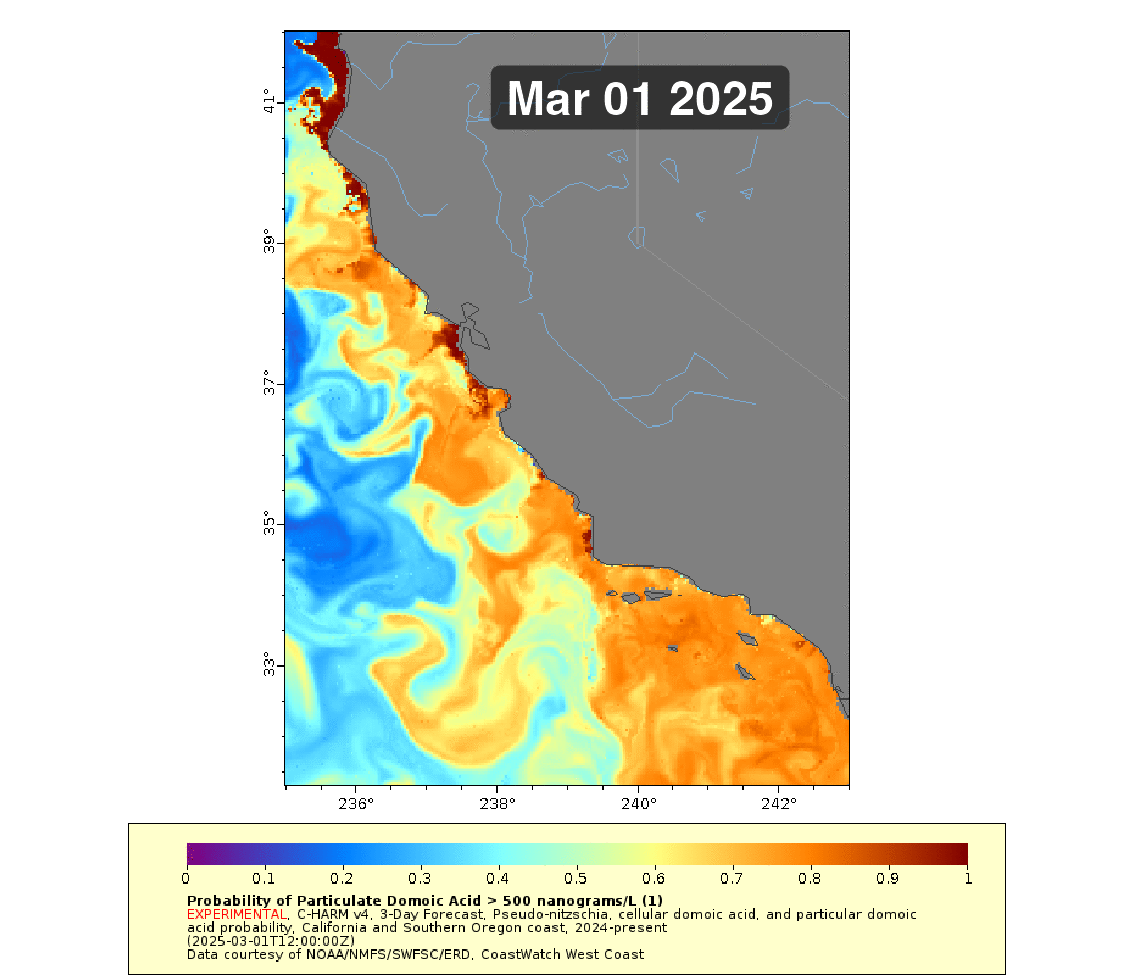
Cellular Domoic Acid
Cellular domoic acid (cDA) is the measure of total domoic acid toxin calculated per cell of Pseudo-nitzschia. This forecast provides a probability for where those cells are expected to be producing toxin at high levels (> 10 picograms per cell).
The C-HARM v4 model generates nowcast and forecasts of the probability of Pseudo-nitzschia concentrations of in excess of 10,000 cells/L, the probability of particulate domoic acid > 500 nanograms/L, and the probability of cellular domoic acid > 10 picograms/cell in California and Southern Oregon coastal waters. Inputs for the model include near real-time satellite observations, gap-filled chlorophyll a, 486nm reflectance, and 551nm reflectance fields from the S-NPP NOAA VIIRS sensor plus nowcast and forecast data of surface salinity, sea surface temperature, and surface currents from WCOFS ROMS.
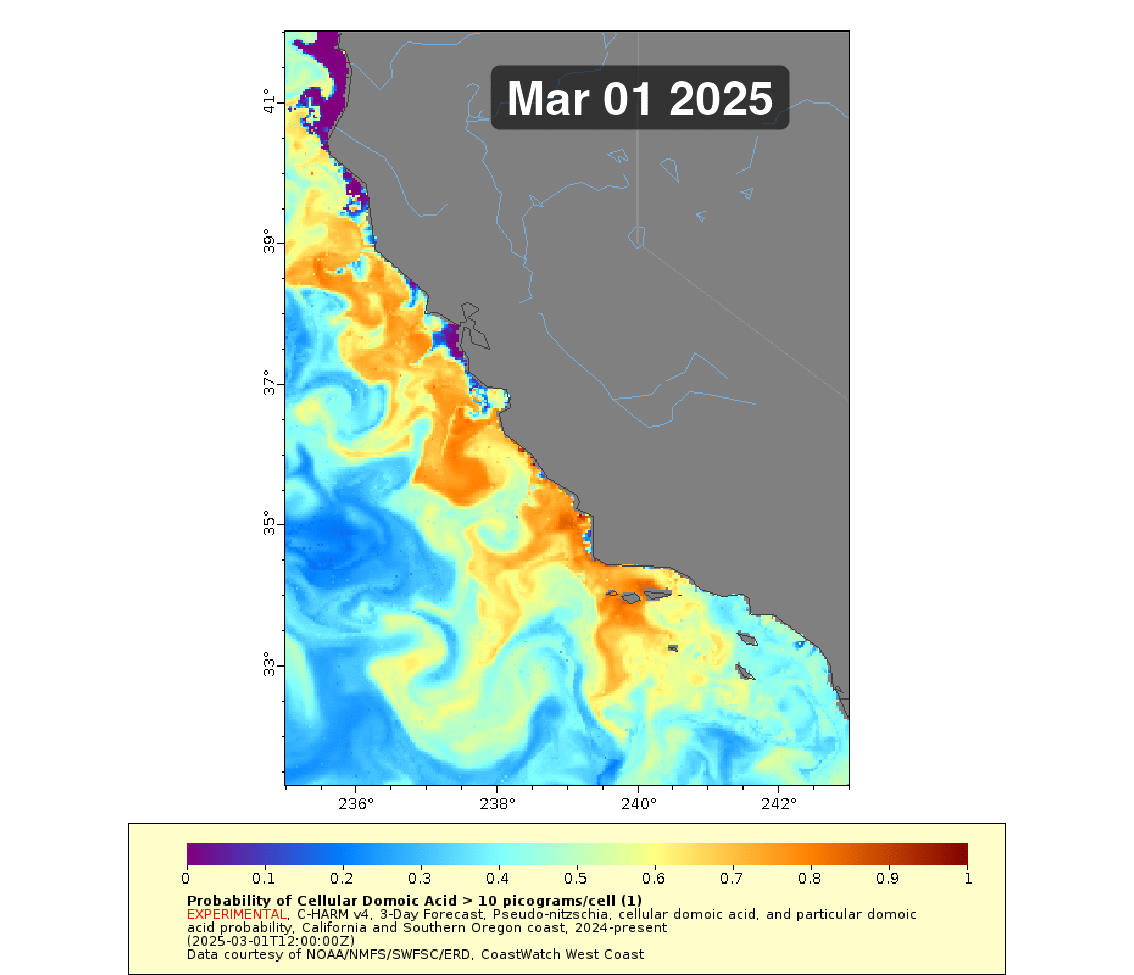
Pseudo-nitzschia
Pseudo-nitzschia is a neurotoxin producing diatom that is observed along the California Coast. Blooms of this phytoplankton can be detrimental to surrounding marine ecosystems. This forecast provides a probability for where the concentration of cells in the water exceed the threshold of a Harmful Algal Bloom ( > 10,000 cells/L).
The C-HARM v4 model generates nowcast and forecasts of the probability of Pseudo-nitzschia concentrations of in excess of 10,000 cells/L, the probability of particulate domoic acid > 500 nanograms/L, and the probability of cellular domoic acid > 10 picograms/cell in California and Southern Oregon coastal waters. Inputs for the model include near real-time satellite observations, gap-filled chlorophyll a, 486nm reflectance, and 551nm reflectance fields from the S-NPP NOAA VIIRS sensor plus nowcast and forecast data of surface salinity, sea surface temperature, and surface currents from WCOFS ROMS.
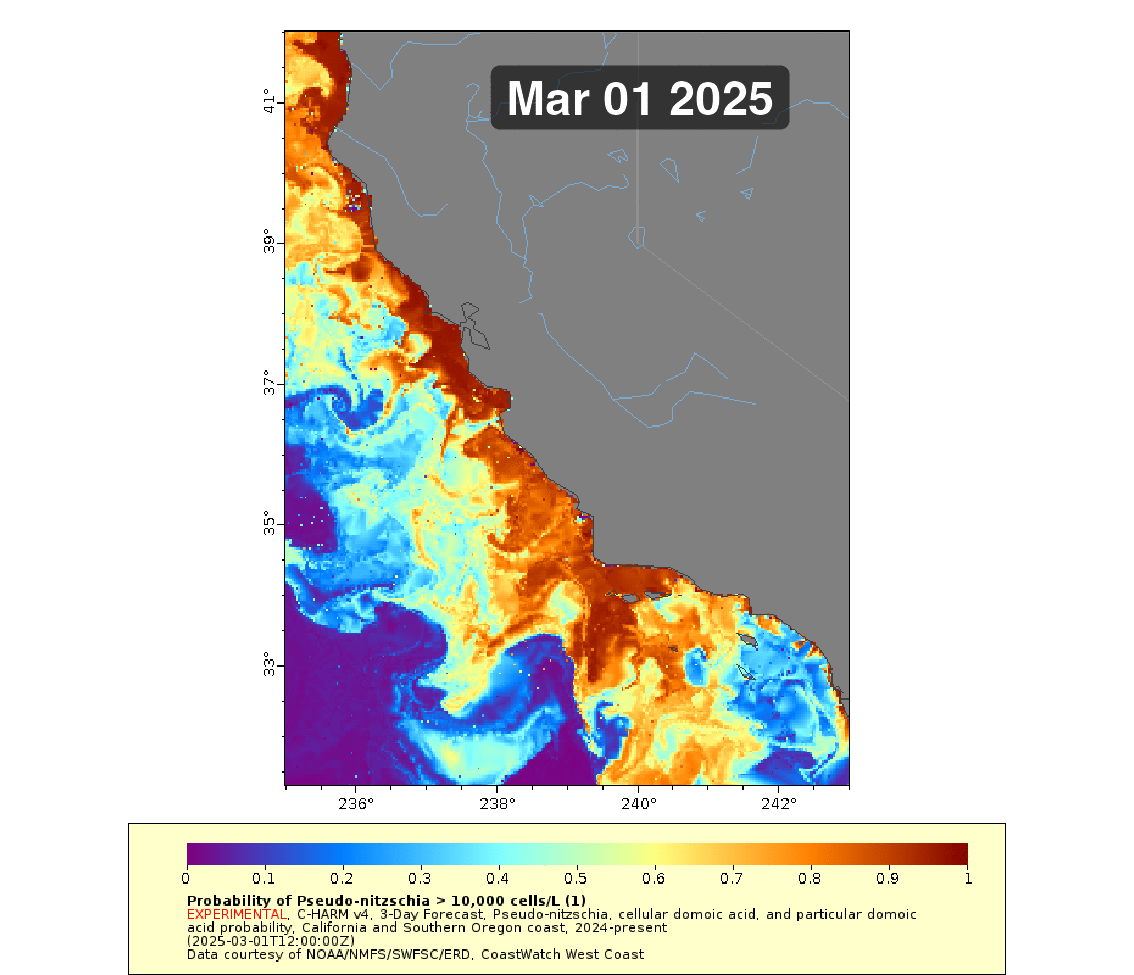
California Harmful Algal Bloom Monitoring & Alert Program
Differentiating Pseudo-nitzschia species by light microscopy is difficult. For this reason, Pseudo-nitzschia “seriata” does not refer to an actual species but rather the larger size class of Pseudo-nitzschia, which is generally a more toxigenic group of species. Alternatively, Pseudo-nitzschia “delicatissima” refers to the smaller size class that is generally non-toxigenic. The dashed line on the plots demarcates the 10,000 cells/L “bloom” threshold designated here for Pseudo-nitzschia populations only.
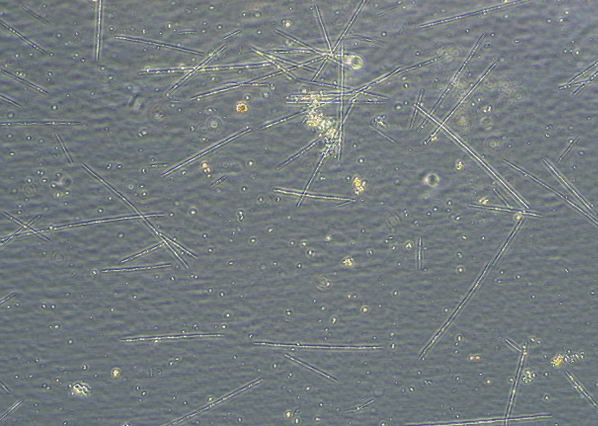
Photo from Steffaney Wood Rocca, SIO, April 30.
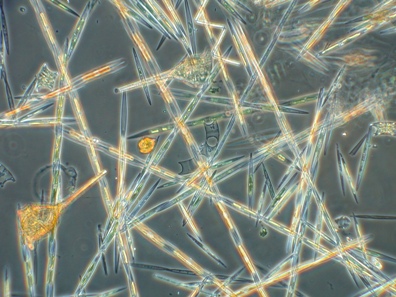
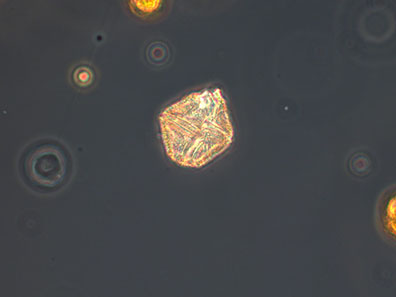
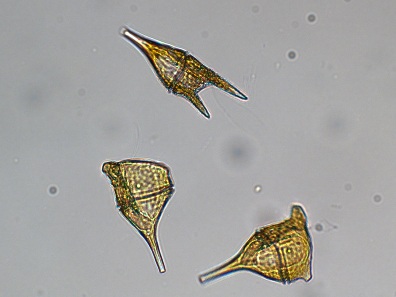
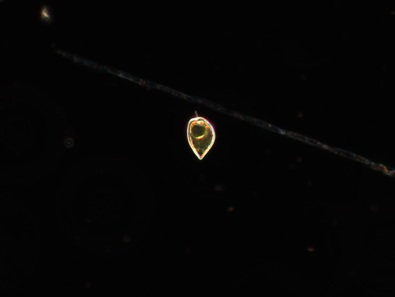
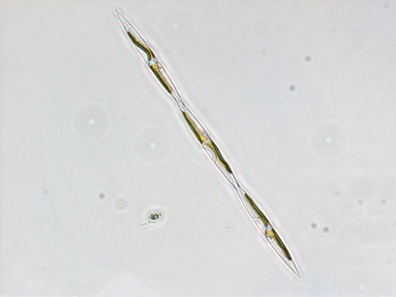
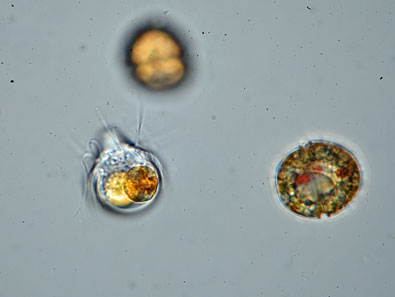
These time series focus on data collected through the scope of this bulletin and the 12 month period that precedes it. Explore the variables and regions that make up the CalHABMAP collective dataset using the plot controls.
More information and data visualizations on the statewide HAB network and forecasting system is found on the California HABMAP website and on the SCCOOS Harmful Algal Bloom page.
A network of Imaging FlowCytobots (IFCBs) continuously photographs particles, such as plankton, in the water. Using machine learning, plankton species can be automatically identified. This will help improve the ability to detect and respond to Harmful Algal Blooms, including the ability to assess conditions that may lead to toxin production or blooms of toxin-producing algae.
These data, coupled with the image classification algorithms developed in collaboration with SCCOOS and CeNCOOS, allow for estimates of species composition over time. The time series below depict sampling outcomes across several California sites. Support provided by NOAA IOOS and CA OPC.
Additional images and data are available on the IFCB dashboard.
Each month, water samples are collected by volunteers and sent to the California Department of Public Health (CDPH) for analysis.
Pseudo-nitzschia ‘seriata’
Alexandrium spp.
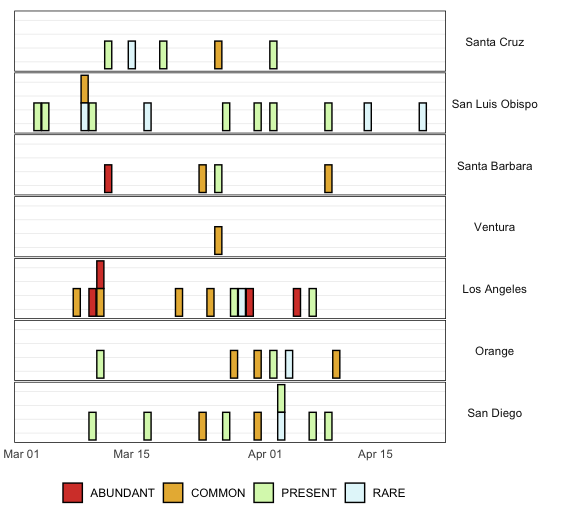
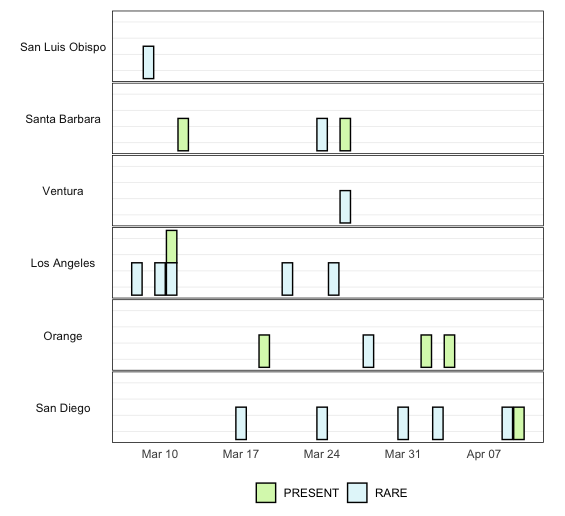
The relative abundance of DA-producing Pseudo-nitzschia ‘seriata’ size class (left) and PSP toxin-producing Alexandrium spp. (right) are catalogued from sample locations within each county. Each bar represents a sample outcome.
Source: California Department of Public Health, Environmental Management Branch.
____
CDPH is advising the public not to consume sport-harvested bivalve shellfish, including mussels, clams, and scallops, gathered from Santa Barbara County. Dangerous levels of paralytic shellfish poisoning (PSP) toxins have been detected in mussels from Santa Barbara County.
____
CDPH is advising the public not to consume sport-harvested bivalve shellfish, including mussels, clams, and scallops, gathered from Los Angeles County and Santa Barbara County. Dangerous levels of domoic acid have been found in shellfish in these areas.
____
CDPH is advising the public not to consume sport-harvested bivalve shellfish, including mussels, clams, scallops, and oysters, gathered from San Diego County. Dangerous levels of domoic acid have been found in shellfish in these areas.
____
CDPH is advising the public not to eat sport-harvested mussels, clams, scallops, or oysters from Ventura, Orange, and San Diego counties. Dangerous levels of paralytic shellfish poisoning (PSP) toxins have been detected in mussels from San Diego County.
Water Sample Detailed Data
| Date_Sampled | County | Sample_Site | PN_Percent_Comp | PN_Density | AL_Percent_Comp | AL_Density |
|---|---|---|---|---|---|---|
| 2025-03-11 | Los Angeles | Santa Monica Bay, 3201 | 71 | ABUNDANT | 2 | PRESENT |
| 2025-02-17 | San Diego | Oceanside Harbor | 70 | ABUNDANT | 0 | ABSENT |
| 2025-03-12 | Santa Barbara | Goleta Pier | 61 | ABUNDANT | 5 | PRESENT |
| 2025-02-13 | San Diego | San Diego Bay, U.S. Navy Pier | 45 | COMMON | 0 | ABSENT |
| 2025-02-18 | San Diego | La Jolla, Scripps Pier | 45 | COMMON | 0 | ABSENT |
| 2025-02-24 | Los Angeles | Manhattan Beach Pier | 45 | COMMON | 0 | ABSENT |
| 2025-03-08 | Los Angeles | Palos Verdes Rocky Pt Offshore | 37.5 | COMMON | 0.5 | RARE |
| 2025-02-14 | Orange | Dana Pt. Harbor | 30 | COMMON | 0 | ABSENT |
| 2025-03-11 | Los Angeles | Redondo Beach Pier | 26 | COMMON | 0.5 | RARE |
| 2025-02-23 | Los Angeles | Catalina Island, OFFSHORE | 25 | COMMON | 0 | ABSENT |
| 2025-02-21 | Santa Barbara | Santa Barbara, Mohawk Reef | 22 | COMMON | 1 | PRESENT |
| 2025-03-09 | San Luis Obispo | Pismo Pier | 15 | COMMON | 0.5 | RARE |
| 2025-02-18 | Los Angeles | Palos Verdes Rocky Pt Offshore | 10 | COMMON | 0 | ABSENT |
| 2025-03-01 | Los Angeles | Palos Verdes Rocky Pt Offshore | 10 | COMMON | 0 | ABSENT |
| 2025-02-19 | San Diego | San Diego Harbor, Pier 159 | 9 | PRESENT | 0 | ABSENT |
| 2025-03-19 | Santa Cruz | Santa Cruz Wharf | 6 | PRESENT | 0 | ABSENT |
| 2025-02-10 | Marin | Tomales Bay, Lease #M430-15 | 5 | PRESENT | 0 | ABSENT |
| 2025-02-15 | Los Angeles | Catalina Island, Avalon Bay | 5 | PRESENT | 0 | ABSENT |
| 2025-02-21 | Santa Barbara | Santa Barbara Ch., Naples Pt | 5 | PRESENT | 6 | PRESENT |
| 2025-02-11 | Santa Barbara | Goleta Pier | 4 | PRESENT | 0 | ABSENT |
| 2025-02-10 | Mendocino | Mendocino, Noyo Harbor | 3 | PRESENT | 0 | ABSENT |
| 2025-02-26 | San Diego | Imperial Beach Pier | 3 | PRESENT | 0 | ABSENT |
| 2025-03-04 | San Luis Obispo | Port San Luis, Diablo Cove | 3 | PRESENT | 0 | ABSENT |
| 2025-02-26 | Orange | San Clemente Pier | 2 | PRESENT | 0 | ABSENT |
| 2025-02-28 | San Diego | San Diego Bay, U.S. Navy Pier | 1 | PRESENT | 0.5 | RARE |
| 2025-03-03 | San Luis Obispo | Morro Bay, Boat Launch | 1 | PRESENT | 0 | ABSENT |
| 2025-03-10 | San Diego | La Jolla, Scripps Pier | 1 | PRESENT | 0 | ABSENT |
| 2025-02-10 | San Luis Obispo | Morro Bay, Boat Launch | 0.5 | RARE | 0 | ABSENT |
| 2025-02-17 | San Luis Obispo | Morro Bay, Boat Launch | 0.5 | RARE | 0 | ABSENT |
| 2025-02-10 | San Diego | La Jolla, Scripps Pier | 0.5 | RARE | 0 | ABSENT |
| 2025-02-24 | Marin | Tomales Bay, Lease #M430-15 | 0.5 | RARE | 0 | ABSENT |
| 2025-02-14 | Orange | Bolsa Chica | 0.5 | RARE | 0 | ABSENT |
| 2025-03-03 | Marin | Tomales Bay, Lease #M430-15 | 0.5 | RARE | 0 | ABSENT |
| 2025-03-05 | Monterey | Monterey Bay, Commercial Wharf | 0.5 | RARE | 0 | ABSENT |
| 2025-03-08 | San Mateo | Pillar Point Harbor | 0.5 | RARE | 0 | ABSENT |
| 2025-02-27 | Orange | Newport Bay, Back Bay | 0.5 | RARE | 0 | ABSENT |
| 2025-03-18 | Marin | Point Richmond, Ferry Point | 0.5 | RARE | 0 | ABSENT |
| 2025-03-17 | San Luis Obispo | Morro Bay, Boat Launch | 0.5 | RARE | 0 | ABSENT |
| 2025-03-09 | San Luis Obispo | Cayucos Pier | 0.5 | RARE | 0 | ABSENT |
| 2025-03-10 | Mendocino | Point Arena Pier | 0.5 | RARE | 0 | ABSENT |
| 2025-02-10 | Humboldt | Humboldt Bay, Indian Is. Ch. | 0 | ABSENT | 0 | ABSENT |
| 2025-02-12 | Humboldt | Trinidad Pier | 0 | ABSENT | 0 | ABSENT |
| 2025-02-12 | Santa Cruz | Santa Cruz Wharf | 0 | ABSENT | 0 | ABSENT |
| 2025-02-18 | Humboldt | Humboldt Bay, Indian Is. Ch. | 0 | ABSENT | 0 | ABSENT |
| 2025-02-17 | Marin | Tomales Bay, Lease #M430-15 | 0 | ABSENT | 0 | ABSENT |
| 2025-02-10 | Mendocino | Point Arena Pier | 0 | ABSENT | 0 | ABSENT |
| 2025-02-11 | Del Norte | Wilson Creek | 0 | ABSENT | 0 | ABSENT |
| 2025-02-28 | Marin | Richmond, Marina Bay Harbor | 0 | ABSENT | 0 | ABSENT |
| 2025-02-24 | Humboldt | Humboldt Bay, Indian Is. Ch. | 0 | ABSENT | 0 | ABSENT |
| 2025-02-24 | San Luis Obispo | Morro Bay, Boat Launch | 0 | ABSENT | 0 | ABSENT |
| 2025-02-26 | Marin | Drakes Bay, Chimney Rock LBS | 0 | ABSENT | 0 | ABSENT |
| 2025-02-18 | Orange | Newport Bay, Back Bay | 0 | ABSENT | 0 | ABSENT |
| 2025-02-25 | San Mateo | Bean Hollow State Beach | 0 | ABSENT | 0 | ABSENT |
| 2025-02-25 | San Mateo | Pillar Point Harbor | 0 | ABSENT | 0 | ABSENT |
| 2025-02-27 | Del Norte | Hunter Rock, north | 0 | ABSENT | 0 | ABSENT |
| 2025-02-24 | San Diego | La Jolla, Scripps Pier | 0 | ABSENT | 0 | ABSENT |
| 2025-02-24 | Sonoma | Shell Beach, Sea Ranch | 0 | ABSENT | 0 | ABSENT |
| 2025-02-26 | Santa Barbara | Goleta Pier | 0 | ABSENT | 1 | PRESENT |
| 2025-02-28 | San Mateo | Pillar Point Harbor | 0 | ABSENT | 0 | ABSENT |
| 2025-03-03 | Humboldt | Humboldt Bay, Indian Is. Ch. | 0 | ABSENT | 0 | ABSENT |
| 2025-02-17 | Mendocino | Mendocino, Noyo Harbor | 0 | ABSENT | 0 | ABSENT |
| 2025-02-11 | Orange | Newport Bay, Back Bay | 0 | ABSENT | 0 | ABSENT |
| 2025-02-24 | Sonoma | Kashia Coastal Reserve | 0 | ABSENT | 0 | ABSENT |
| 2025-02-27 | Del Norte | Wilson Creek | 0 | ABSENT | 0 | ABSENT |
| 2025-03-04 | Mendocino | Mendocino, Noyo Harbor | 0 | ABSENT | 0 | ABSENT |
| 2025-03-05 | Santa Cruz | Santa Cruz Wharf | 0 | ABSENT | 0 | ABSENT |
| 2025-02-21 | Orange | Bolsa Chica | 0 | ABSENT | 0.5 | RARE |
| 2025-03-12 | Santa Cruz | Santa Cruz Wharf | 0 | ABSENT | 0 | ABSENT |
| 2025-03-05 | Sonoma | Kashia Coastal Reserve | 0 | ABSENT | 0 | ABSENT |
| 2025-03-10 | San Luis Obispo | Morro Bay, Boat Launch | 0 | ABSENT | 0 | ABSENT |
| 2025-03-10 | Humboldt | Humboldt Bay, Indian Is. Ch. | 0 | ABSENT | 0 | ABSENT |
| 2025-03-04 | San Diego | La Jolla, Scripps Pier | 0 | ABSENT | 0 | ABSENT |
| 2025-02-28 | Orange | Bolsa Chica | 0 | ABSENT | 0 | ABSENT |
| 2025-03-10 | Marin | Tomales Bay, Lease #M430-15 | 0 | ABSENT | 0 | ABSENT |
| 2025-02-25 | Mendocino | Point Arena Pier | 0 | ABSENT | 0 | ABSENT |
| 2025-03-17 | Humboldt | Humboldt Bay, Indian Is. Ch. | 0 | ABSENT | 0 | ABSENT |
| 2025-03-10 | Del Norte | Wilson Creek | 0 | ABSENT | 0 | ABSENT |
| 2025-02-25 | Mendocino | Mendocino, Noyo Harbor | 0 | ABSENT | 0 | ABSENT |
| 2025-03-06 | San Mateo | Pillar Point Harbor | 0 | ABSENT | 0 | ABSENT |
| 2025-03-05 | Orange | Bolsa Chica | 0 | ABSENT | 0 | ABSENT |
| 2025-03-24 | Marin | Tomales Bay, Lease #M430-15 | 0 | ABSENT | 0 | ABSENT |
| 2025-03-06 | San Diego | San Diego Bay, U.S. Navy Pier | 0 | ABSENT | 0 | ABSENT |
| 2025-03-11 | Mendocino | Mendocino, Noyo Harbor | 0 | ABSENT | 0 | ABSENT |
| 2025-03-24 | Humboldt | Humboldt Bay, Indian Is. Ch. | 0 | ABSENT | 0 | ABSENT |
| 2025-03-11 | Del Norte | Wilson Creek | 0 | ABSENT | 0 | ABSENT |
| 2025-03-24 | San Luis Obispo | Morro Bay, Boat Launch | 0 | ABSENT | 0 | ABSENT |
| 2025-03-04 | Orange | Newport Bay, Back Bay | 0 | ABSENT | 0 | ABSENT |
Percent composition categories help us look at phytoplankton trends across an entire region to evaluate risk of biotoxin presence. Many other factors contribute to our evaluation of risk in an area. These samples are posted for informational purposes only. They are not intended to inform the public of the presence or lack of risk. For the latest health advisory information, see the CDPH Health Advisory Map below.
domoic acid related strandings in March-April 2025
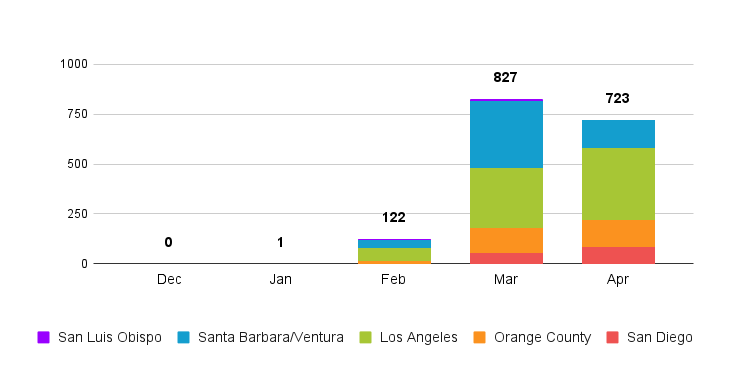
Domoic acid (DA) is a potent neurotoxin produced by some diatom species of the genus Pseudo-nitzschia. Species exposed to DA can result in seizures, epilepsy, cardiomyopathy, and death depending upon the ingested dose. DA toxicosis commonly occurs in California sea lions (Zalophus californianus), presumably due to a combination of foraging behavior and seasonal movements.
The Marine Mammal Center (TMMC), Channel Islands Marine Wildlife Institute (CIMWI), California Wildlife Center (CWC), Marine Mammal Care Center Los Angeles (MMCC-LA), Pacific Marine Mammal Center (PMMC), SeaWorld, and Southwest Fisheries Science Center (SWFSC) act like an emergency room by working to rescue and rehabilitate sick and injured marine mammals, seabirds, and sea turtles.
An overview of this active event and current forecast for domoic acid risk can be explored below.
Support Marine Mammal Rescue Centers
Marine mammal rescue centers have gone above and beyond in responding to the recent harmful algal bloom (HAB) crisis, which brought an unprecedented surge in sick and stranded animals. Hundreds of cases have overwhelmed facilities, stretching staff, volunteers, and resources to their limits. These dedicated teams have worked tirelessly around the clock to save as many lives as possible.
But the effort has come at a cost – medical supplies, staffing, transportation, and basic operations have been severely depleted. Now more than ever, they need our support to continue their lifesaving work.
Please consider donating to your local marine mammal rescue center. Your contribution helps restore essential resources and ensures they can keep protecting vulnerable marine life.
Together, we can help them recover, rebuild, and prepare for whatever comes next.
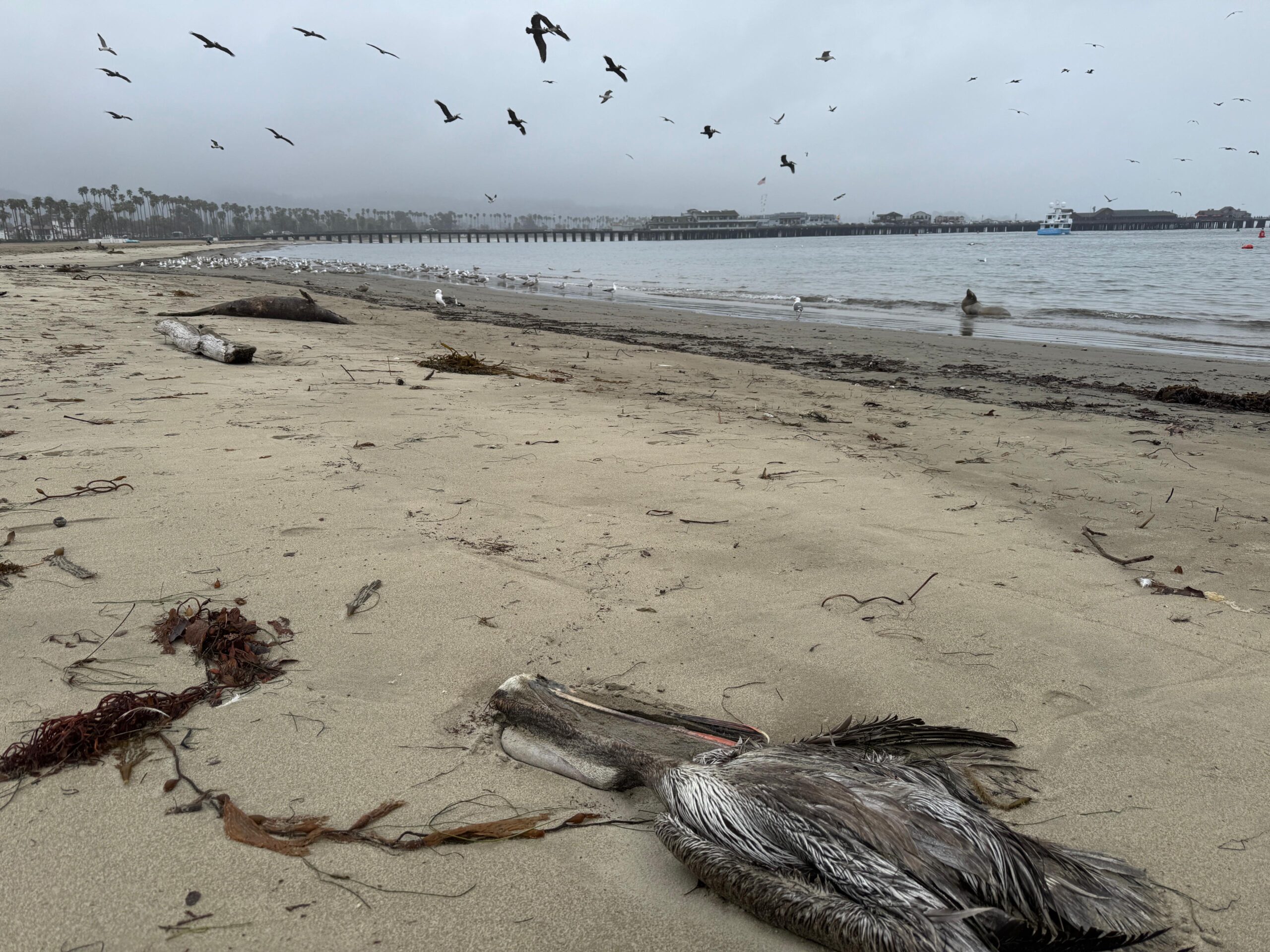
California HAB Bulletin
All data and reports have been synthesized by SCCOOS for the California Harmful Algal Bloom Monthly Bulletin.
Data Access & Resources:
C-HARM, NOAA CoastWatch ERDDAP
Toxic Phytoplankton Observations, CDPH
Imaging FlowCytoBot Dashboard
CalHABMAP Datasets, SCCOOS ERDDAP


